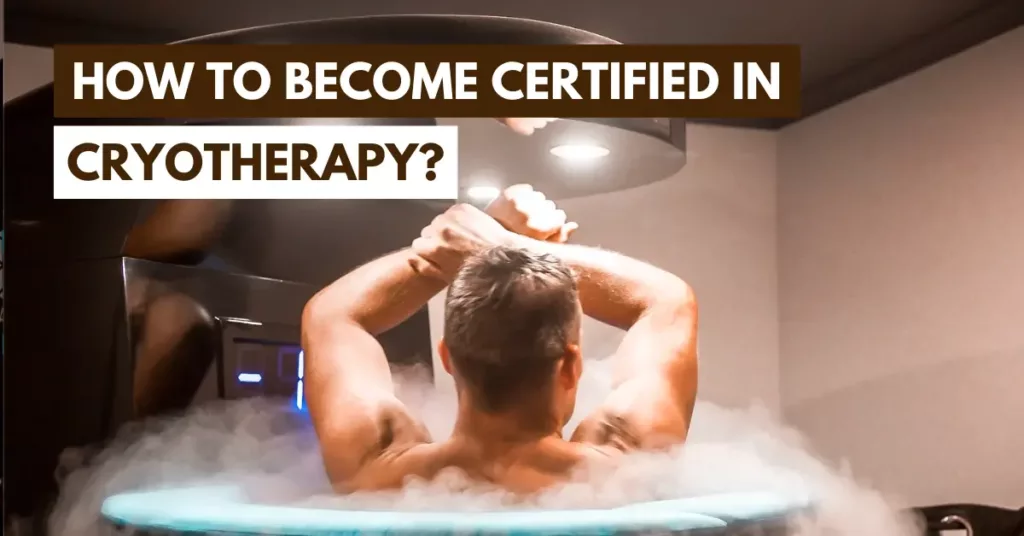Cryotherapy is a legitimate and quickly expanding wellness practice with many advantages, from muscle rehabilitation to better skin health. We’re ready to trek through the icy landscape of cryotherapy certification. How to become certified in cryotherapy?
What abilities, know-how, and methods are necessary to negotiate the frigid world of cryotherapy successfully? Let us begin an exciting journey to learn certified in cryotherapy in 2024. Prepare to embrace the cold and delve deeply into the field of cryotherapy certification!
How Does One Become Licensed to Practice Cryotherapy?
The therapeutic technique known as cryotherapy, which involves exposing the body to extremely low temperatures, has gained appeal because it claims to hasten muscle recovery, reduce inflammation, and improve general health. This guide will help you get certified in cryotherapy.
Step 1: Recognise the Fundamentals of Cryotherapy
It’s imperative to have a firm understanding of what cryotherapy entails before being certified. Learn about the pros, cons, and limitations of the several types of cryotherapy, including localized and whole-body cryotherapy (WBC).
Step 2: Acquire the Necessary Education
It is advantageous to have experience in a relevant industry, such as healthcare, fitness, or wellness, to pursue certification in cryotherapy. Prior knowledge can give you a competitive edge and a more excellent grasp of the subject, albeit it is not necessarily a prerequisite.
Step 3: Select a Trustworthy Certification Program
Pick a respectable and widely respected cryotherapy certification program. Look for programs provided by businesses that follow safety regulations and industry requirements. Several well-known organizations, including delivering cryotherapy certificates,
- The ICA, or International Cryotherapy Association
The Certified Cryotherapy Technician (CCT) program, offered by ICA, teaches cryotherapy methods, safety procedures, and client care.
- Institute for Cryotherapy Training (CTI)
CTI offers a thorough certification program that covers the principles, safety, and standards for various forms of cryotherapy.
- Certified Wellness Council (CWC)
The Certified Cryogenic Recovery Specialist (CCRS) certification program from CWC focuses on the physiological and physical consequences of cryotherapy.
Step 4: Satisfy the Eligibility Criteria
Verify the precise qualifying requirements for the certification program you’ve chosen. A high school diploma or specific hours of relevant experience may be a requirement for some programs.
Step 5: Become a Member of the Certification Program
Enroll in the certification program you choose after proving you are eligible. These courses frequently come in-person or online, giving prospective cryotherapy technicians options.
Step 6: Finish the Training
You will learn all there is to know about cryotherapy during the certification program, including:
- Maintenance and operation of cryotherapy equipment.
- Safety procedures to guarantee consumers’ safety.
- Methods for performing localized and full-body cryotherapy treatments.
- Identifying health concerns and contraindications.
- Correctly assessing and consulting with clients.
- Identifying any adverse effects and taking appropriate action.
Step 7: Succeed on the Certification Test
A final exam is typically part of cryotherapy certification programs to evaluate your knowledge and abilities. This test must be passed to receive your certification.
Step 8: Obtain Real-World Experience
Once you’ve finished the certification program and passed the exam, look for chances to get some real-world experience. A predetermined number of supervised client hours must be completed to complete many certification programs.
Step 9: Keep Up Your Further Education
Attending workshops and continuing education classes will inform you about the newest cryotherapy advancements. Cryotherapy is a profession that is constantly changing. Always keep studying to give patients the best care possible.
Step 10: To Become Certified
Your cryotherapy certification will be granted once you have finished the necessary training, aced the test, and accrued relevant experience. This accreditation recognizes your proficiency and dedication to providing secure and efficient cryotherapy treatments.
Step 11: Develop Your Career
You can start a career as a trained cryotherapy technician or practitioner once you have your certification. Think about working in a cryotherapy office, wellness center, gym, or opening your own cryotherapy company.
Step 12: Keep Certification
Certifications for cryotherapy often need to be renewed every few years. Keep current with industry standards and safety procedures and any continuing education requirements to keep your certificate.
The Equalizing Effects of Cryotherapy
The legal considerations surrounding cryotherapy are essential to ensure the safety and well-being of clients, uphold industry standards, and mitigate potential liabilities. Here, we will detail the legal aspects and regulations related to cryotherapy.
1. Informed Consent
- Cryotherapy providers must obtain informed consent from clients before administering any cryotherapy treatment.
- Informed consent involves explaining the procedure, potential risks, benefits, and potential contraindications to the client.
2. Contraindications and Screening
- Providers must conduct thorough client assessments and screenings to identify any contraindications or health conditions that may make cryotherapy unsafe for the client.
- Not everyone should use cryotherapy. Some patients, including those with circulation problems, heart problems, and pregnancy, may be at risk.
3. Training and Certification
- Technicians and practitioners who use cryotherapy must complete appropriate training and get accreditation from respectable organizations.
- The suitable certification guarantees that service providers are informed about client care, safety procedures, and the safe functioning of cryotherapy equipment. Exams are frequently a part of certification programs to judge proficiency.
4. Device Security
- Providers of cryotherapy must follow stringent maintenance and equipment safety guidelines.
- It is essential to guarantee cryotherapy chambers or equipment’s security and appropriate upkeep. Regular inspections, maintenance, and adherence to manufacturer specifications are required to avoid mishaps involving equipment.
5. Data Security and Client Privacy
- Providers of cryotherapy must protect customer confidentiality and data security.
- Providers must safeguard customer information per laws and regulations governing data privacy, such as the US Health Insurance Portability and Accountability Act (HIPAA). Protecting client health information and personal data is part of this.
6. Liability and Insurance Coverage
- Providers of cryotherapy should have the necessary insurance to guard against any liabilities.
- Accidents or injuries might happen during cryotherapy procedures, and providers could be held responsible. In the case of a lawsuit, liability insurance can assist in defraying court costs and settlement amounts.
7. Compliance with the Occupational Safety and Health Administration (OSHA)
- Providers are required to follow OSHA rules on worker safety.
- The safety of both clients and staff is guaranteed by adherence to OSHA rules in cryotherapy facilities, which are workplaces. This entails preserving a secure workplace and resolving any risks.
8. State and Local Regulations
- Cryotherapy providers must abide by federal, state, and local laws and regulations.
- Location-specific laws may apply to cryotherapy. Any local licensing, permitting, or zoning regulations must be known to and followed by providers.
9. Compliance with advertising and marketing
- The providers must ensure that any promises made in their marketing and promotional materials are accurate.
- There may be legal repercussions for deceptive or fraudulent advertising. Providers in their marketing materials should adequately portray the advantages and dangers of cryotherapy.
10. Laws that Protect Consumers
- Customers’ rights and any consumer protection regulations, such as those governing refund procedures, should be known by providers.
- Legal action may be taken if consumer protection laws are broken. Providers should treat customers properly and have open policies in place.
11. Emergency Procedures
- Emergency measures should be in place for cryotherapy facilities, including steps for dealing with mishaps or negative responses.
- Being prepared for catastrophes is essential for protecting clients. Employees must be trained on how to manage different crises.
- Cryotherapy practitioners must abide by specific legal issues to continue operating safely and legally.
How to Keep Your Cryotherapy Certification Current Over Time
Maintaining your cryotherapy certification is crucial to staying current with industry standards, safety procedures, and best practices throughout your career. Here are broad guidelines to help you keep your cryotherapy certification throughout your lifetime, while certification standards may change according to the organization that awarded your certificate:
1. Understanding the Prerequisites for Certification
Review the certifying organization’s rules and particular certification criteria. Recognize the requirements for continuous education, the frequency of renewal, and any other specific requirements.
2. Finished with Continuing Education
Attending conferences, workshops, seminars, and continuing education courses can help you stay updated with cryotherapy breakthroughs. Select educational options that are relevant to the area of your certification.
3. Maintain Continuing Education Records
Keep careful track of every aspect of your ongoing education. Dates, subjects, lecturers, and hours or credits obtained should all be documented. When it comes time for your certification to be renewed, this record will be helpful.
4. Obtain a New Certification
Remember when your certification expires and submit your application for renewal before the deadline. According to some certifying organizations, you may need to pass a renewal exam or accrue certain continuing education credits.
5. Renewing Fees to Pay
Be aware of any renewal costs necessary to keep your certification. Make careful to pay these fees on time to prevent accreditation.
6. Keep up with Industry Changes
Keep up-to-date with modifications to the cryotherapy sector’s safety norms and rules. Sign up for newsletters, journals, and websites to stay current on industry news.
7. Attend Webinars and Workshops
Attend workshops, webinars, and online courses on cryotherapy. Participating in one of the many organizations’ web-based training programs is a handy option to obtain continuing education credits.
8. Cooperate and Network
Participate in networking events, forums, and industry groups to interact with other cryotherapy professionals. Peer collaboration can lead to the sharing of important discoveries.
9. Mentor or Volunteer
Think about mentoring prospective cryotherapy practitioners or giving of your time and knowledge. Participating actively in the cryotherapy community might help you learn more and expand your network of contacts.
10. Keeping Records
Throughout your career, keep meticulous records of all your certifications, continuing education credits, and other credentials. Concerning renewals and possible employment prospects, these documents will be necessary.
11. Request Evaluation and Feedback
Obtain evaluations and suggestions from superiors, role models, or colleagues in the industry. You can find your areas of growth and progress using constructive criticism.
12. Maintain Ethical Standards Compliance
Follow the moral guidelines and recommended procedures in your industry. Keep your job at a high standard of professionalism and honesty to protect the standing of your certification.
13. Take a Look at Advanced Certifications
Investigate chances for higher qualifications or cryotherapy specialization as your work develops. Your professional status and talents can improve with these certificates.
14. Be Prepared for Renewal
Plan for certification renewal by setting up a calendar or other reminder mechanism. By ensuring you have the necessary continuing education credits far in advance, you may avoid the stress of a last-minute renewal.
You may keep your cryotherapy certification for a lifetime by adhering to these guidelines and being dedicated to continued education and professional development. This perseverance shows that you are committed to staying current in your area and care about giving your clients access to safe and efficient cryotherapy.
Last Note
By becoming a trained cryotherapy technician or practitioner, one can start a rewarding career in the rapidly expanding field of cryotherapy. By carefully following the step-by-step instructions and choosing a trustworthy certification program, you can give safe and efficient cryotherapy treatments to clients eager to benefit from its wealth of advantages.
Frequently Asked Questions (FAQs)
Q: How long does it usually take to get a certification in cryotherapy?
A: According to the program’s intensity and structure, certification programs can range from a few days to weeks.
Q: What subjects are included in cryotherapy certification programs?
A: The use of cryotherapy equipment, safety precautions, client assessment, therapeutic approaches, and post-treatment care are common topics included in certification programs.
Q: How to become certified in cryotherapy online?A: Numerous cryotherapy certification programs provide online training, allowing anyone to obtain certification from anywhere.
How to start a bamboo clothing business



